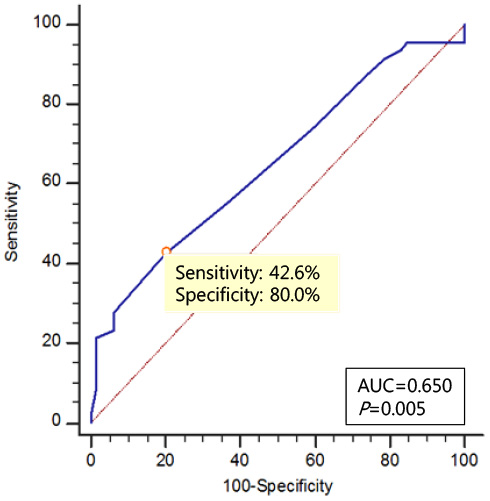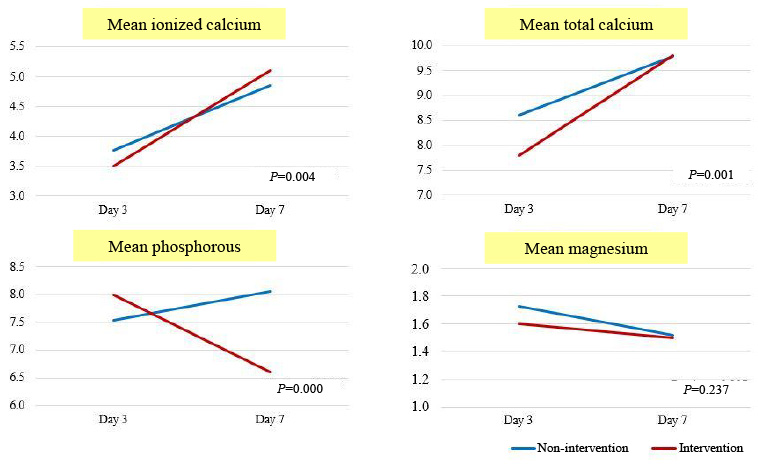Perinatology.
2019 Dec;30(4):208-213. 10.14734/PN.2019.30.4.208.
Perinatal Risk Factors for Early Onset Hypocalcemia in Moderate-to-Late Preterm Infants
- Affiliations
-
- 1Department of Pediatrics, Korea University College of Medicine, Seoul, Korea. frinky@hanmail.net
- KMID: 2468541
- DOI: http://doi.org/10.14734/PN.2019.30.4.208
Abstract
OBJECTIVE
Early onset neonatal hypocalcemia (ENH) occurs within 72 hours after birth and screening is recommended for high-risk infants. This study aimed to analyze the risk factors predictive of ENH and evaluate the effectiveness of intervention for ENH in moderate-to-late preterm infants.
METHODS
This was a retrospective study, examining moderate-to-late preterm infants at 32-36 weeks of gestational age. Perinatal factors were compared between infants with and without hypocalcemia. Related factors were further analyzed to evaluate the validity of the predictive factors for ENH. The effect of intervention was analyzed by comparing changes in serum calcium levels on day 3 and day 7.
RESULTS
A total of 112 infants were enrolled. There were 65 infants in the non-hypocalcemic group and 47 in the hypocalcemic group. Between the two groups, only lower magnesium levels on day 1 were related to ENH with an odds ratio of 0.247 using a cutoff value of 1.7 mmol/L for hypocalcemia (sensitivity 42.6%, specificity 80.0%, P=0.005). No infant with hypocalcemia exhibited clinical seizures. Intervention was performed with oral calcium supplements or low-phosphorus milk feeding in 30 infants. The intervention was more effective in resolving hypocalcemia than no intervention (n=17).
CONCLUSION
Lower magnesium levels on day 1 were related to lower calcium levels and a 4-fold higher risk for hypocalcemia. Moderate-to-late preterm infants with hypomagnesemia should be closely monitored for ENH. Additionally, interventions were found to be effective in restoring calcium levels in ENH.
Keyword
MeSH Terms
Figure
Reference
-
1. Jain A, Agarwal R, Sankar MJ, Deorari A, Paul VK. Hypocalcemia in the newborn. Indian J Pediatr. 2010; 77:1123–1128.
Article2. Picone S, Paolillo P. Neonatal outcomes in a population of late-preterm infants. J Matern Fetal Neonatal Med. 2010; 23:116–120.
Article3. Mayne PD, Kovar IZ. Calcium and phosphorus metabolism in the premature infant. Ann Clin Biochem. 1991; 28:131–142.
Article4. Kovacs CS. Calcium, phosphorus, and bone metabolism in the fetus and newborn. Early Hum Dev. 2015; 91:623–628.
Article5. Venkataraman PS, Tsang RC, Steichen JJ, Grey I, Neylan M, Fleischman AR. Early neonatal hypocalcemia in extremely preterm infants. High incidence, early onset, and refractoriness to supraphysiologic doses of calcitriol. Am J Dis Child. 1986; 140:1004–1008.6. Bagnoli F, Bruchi S, Garosi G, Pecciarini L, Bracci R. Relationship between mode of delivery and neonatal calcium homeostasis. Eur J Pediatr. 1990; 149:800–803.
Article7. Brown JV, Embleton ND, Harding JE, McGuire W. Multi-nutrient fortification of human milk for preterm infants. Cochrane Database Syst Rev. 2016; (5):CD000343.
Article8. Nelson N, Finnström O, Larsson L. Plasma ionized calcium, phosphate and magnesium in preterm and small for gestational age infants. Acta Paediatr Scand. 1989; 78:351–357.
Article9. Cloherty JP, Eichenwald EC, Hansen AR, Soul JS. Perinatal asphyxia and hypoxic-ischemic encephalopathy. Manual of neonatal care. 7th ed. Philadelphia: Lippincott Williams & Wilkins;2011. p. 711–728.10. Rai S, Bhatiyani KK, Kaur S. Effect of birth asphyxia on serum calcium and glucose level: a prospective study. Int J Sci Study. 2015; 3:3–6.11. Thomas TC, Smith JM, White PC, Adhikari S. Transient neonatal hypocalcemia: presentation and outcomes. Pediatrics. 2012; 129:e1461–e1467.
Article12. Tsang RC, Kleinman LI, Sutherland JM, Light IJ. Hypocalcemia in infants of diabetic mothers. Studies in calcium, phosphorus, and magnesium metabolism and parathormone responsiveness. J Pediatr. 1972; 80:384–395.13. Bergman L, Kjellmer I, Selstam U. Calcitonin and parathyroid hormone-relation to early neonatal hypocalcemia in infants of diabetic mothers. Biol Neonate. 1974; 24:151–160.14. Taneja A, Arora K, Chopra I, Naik SS. Pregnancy outcomes in isolated oligohydramnios during second trimester: a case series. J Clin Diagn Res. 2017; 11:QR01-QR02.
Article15. Sheth DP. Hypocalcemic seizures in neonates. Am J Emerg Med. 1997; 15:638–641.
Article16. Dokos C, Tsakalidis C, Manaridou K, Karayianni P, Kyrkos I, Roussos I. Clinical-laboratory findings of bone metabolism in healthy premature and full-term neonates: preliminary results. Clin Cases Miner Bone Metab. 2017; 14:167–172.
Article17. Cockburn F, Brown JK, Belton NR, Forfar JO. Neonatal convulsions associated with primary disturbance of calcium, phosphorus, and magnesium metabolism. Arch Dis Child. 1973; 48:99–108.
Article18. Buppasiri P, Lumbiganon P, Thinkhamrop J, Ngamjarus C, Laopaiboon M, Medley N. Calcium supplementation (other than for preventing or treating hypertension) for improving pregnancy and infant outcomes. Cochrane Database Syst Rev. 2015; (2):CD007079.
Article19. Harding JE, Wilson J, Brown J. Calcium and phosphorus supplementation of human milk for preterm infants. Cochrane Database Syst Rev. 2017; 2:CD003310.
Article20. Heaton FW. Magnesium relations with parathyroid hormone, calcitonin and bone. Magnes Bull. 1981; 1:67–72.21. Root AW. Endocrinology and metabolism 2014. Curr Opin Pediatr. 2014; 26:472–474.
Article22. Ambadkar A, Prasad M, Chauhan AR. Neonatal effects of maternal magnesium sulphate in late preterm and term pregnancies. J Obstet Gynaecol India. 2019; 69:25–30.
Article23. Das M, Chaudhuri PR, Mondal BC, Mitra S, Bandyopadhyay D, Pramanik S. Assessment of serum magnesium levels and its outcome in neonates of eclamptic mothers treated with low-dose magnesium sulfate regimen. Indian J Pharmacol. 2015; 47:502–508.
Article24. Abbassi-Ghanavati M, Alexander JM, McIntire DD, Savani RC, Leveno KJ. Neonatal effects of magnesium sulfate given to the mother. Am J Perinatol. 2012; 29:795–799.
Article25. Baker SB, Worthley LI. The essentials of calcium, magnesium and phosphate metabolism: part I. Physiology. Crit Care Resusc. 2002; 4:301–306.26. Voet D, Voet JG. Biomolecules, mechanisms of enzyme action, and metabolism. 1st ed. New York: Wiley;2004. p. 663–664.27. Kuhr MD. Early hypocalcemia does not need to be treated. Pediatrics. 1977; 60:388.
Article28. Sann L, David L, Chayvialle JA, Lasne Y, Bethenod M. Effect of early oral calcium supplementation on serum calcium and immunoreactive calcitonin concentration in preterm infants. Arch Dis Child. 1980; 55:611–615.
Article
- Full Text Links
- Actions
-
Cited
- CITED
-
- Close
- Share
- Similar articles
-
- Comparisons of Clinical Characteristics Affecting Readmission between Late Preterm Infants and Moderate Preterm Infants or Full-Term Infants
- Assessment of Preterm Infants Using the Bayley-III Scales in Korea
- A study to compare maternal and perinatal outcome in early vs. late onset preeclampsia
- Neurodevelopmental Outcomes of Moderate-to-Late Preterm Infants
- Neurodevelopmental outcomes of preterm infants



